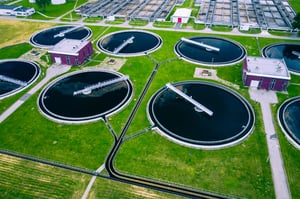Farmers, industrial companies, healthcare professionals, members of the public: all of us are concerned and potentially affected by the problem of water pollution. And on the issue of micropollutants in wastewater, local authorities certainly have a role to play in protecting us. France is leading from the front in terms of regulation, and is setting the benchmark for Europe in its commitment to take action on this issue.
Water pollution poses a danger not only to the balance of natural ecosystems, but also to human health. More specifically, the micropollutants (drug residues, pesticides, heavy metals, etc.) found in wastewater are suspected of being harmful to humans, even when present in only very low concentrations.
Reducing water pollution at source
The first solution to be considered for reducing water pollution is what the authorities refer to as reduction at source. The goal here is to encourage changes to healthcare and hygiene practices and, in the more general sense, the domestic use of products that generate micropollutants. At the same time, hospitals are being encouraged to adopt treatments specific to removing this type of pollution by recovering and treating effluents, especially those from areas of care where patients receive intensive treatment.
Discharges from industrial plants may also be governed by special discharge agreements based on analysis of the effluents concerned, enabling the plant operator to commit formally to a precise level of tolerated environmental disruption. The ultimate aim of these agreements is to ensure that only treated water is discharged, or at the very least that the discharges made by an industrial plant can be effectively treated in the local authority wastewater treatment plant downstream.
Some micropollutants prove more challenging to control
Flows of micropollutants from domestic environments appear more challenging to control. The fact is that they are concealed in products we use every day (medicines, household products, DIY products, etc.). So organic micropollutants may come from many different sources, and are not necessarily industrial or agricultural in origin. For example, products applied to domestic roofs to slow down the formation of moss can be washed off by the rain and ultimately arrive in a wastewater treatment plant.
But however useful it may be, the policy to reduce pollution at source still has its limits, because this widespread form of pollution always seems to find a way to escape.
Treating micropollutants at the wastewater collection point

Another solution for reducing water pollution is for local authorities to treat micropollutants in their wastewater treatment plants. This solution is still rarely used in France, probably because current regulations impose no requirement for local authorities to do so. In most cases, this type of tertiary treatment is used only when the local community concerned has responsibility for a particularly sensitive natural environment (shellfish farming, oyster farming, bathing waters, etc.). Local authorities geographically close to countries where regulations are stricter are also beginning to consider this option. This is currently the case in Switzerland.
Of the thousands of micropollutants in existence, the Swiss authorities have identified twelve particularly problematic target molecules: wastewater treatment plants are now required to remove 80% of the total load of these molecules. Treating these micropollutants is funded by an annual levy of CHF 9 per year, per resident, which will be applied until all wastewater treatment plants are compliant.
This provides the incentive to consider the possibility of introducing a micropollutant treatment policy at local authority level in France ahead of the introduction of similar regulation.
Find out more, and get answers to all your questions by contacting us: